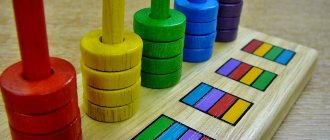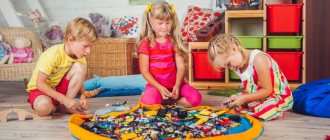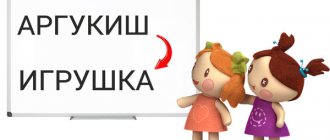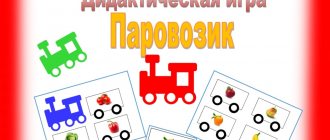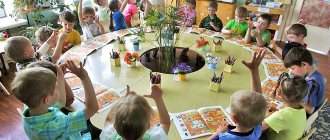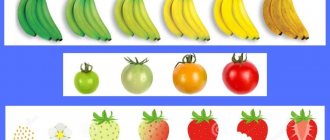Game forms are a universal means of development for preschool children. They contribute to the formation of cognitive processes and the development of the child’s personality. This article provides didactic exercises and games to develop attention in preschoolers. How we develop a child’s attention in preschool age determines how quickly the arbitrariness of this process is formed, and, consequently, the child’s preparedness for school.
Games for younger preschoolers to develop attention
Children aged 3 to 4 years old still have difficulty focusing on speech and verbal exercises. Therefore, in the development of attention it is necessary to use visual perception. It should also be taken into account that the method of cognition in younger preschoolers is visual and effective thinking. Children at this age can look at pictures, repeat actions, and compare objects. These are the games that are suitable for them to train their attention.
- Build like me! Take two sets of cubes of different colors (no more than 5). Sit next to your baby, taking one set for yourself and placing the second one in front of your child. Build a simple structure from your three or four cubes. Invite your child to build the same. If the preschooler succeeded, but without taking into account color, draw his attention to this fact. After praising your child, encourage him to do it again. As the child gets better at it, complicate the designs and add new geometric shapes (cone, cylinder...)
- What do dolls lack? Place three dolls in a row. Tell them what they are going to eat. Place a plate in front of two dolls, a spoon for two more, and also place two cups. Arrange everything so that each doll has two items. There should be utensils on the side, both necessary and unnecessary. Ask the child what is missing from the first doll, the second... Let the child complete the “setting”.
- What have you lost? Draw a simple plot picture: a house, a tree, the sun, a cloud, etc. On a separate sheet of paper, roughly repeat the basis of the drawing from the three main elements. Next, ask your child what else needs to be added, comparing both drawings.
Tips for training attention at home
While walking in the park or on your way to work, try to notice as many little things as possible.
Examine the lawn, count the number of flowers planted in the flower bed, and pay attention to how the border is painted. Remember as many details as possible, and next time try to notice what has changed. Similar task to the previous one
Go to the store. Remember all the details of your journey. Then all the details of the store, every window display. Then go to the store again, only this time mentally. Don't do anything automatically! Often, when leaving the house, we don’t remember whether we locked the door or turned off the iron. Stop, exhale, concentrate your attention on this action. When guests come to you, try to remember what they were wearing, for example, the length and color of the dress, whether there was a tie or not, etc. Try, it would seem, such little things, but you didn’t attach any importance to them. Be curious. The more you want to know about the world, the greater your concentration endurance will be.
We are definitely not robots. It's normal to wonder and find yourself looking out the window or at the sky. And sometimes, these lapses can be good for your brain, giving it some air to breathe. However, many things in life involve focusing mindfulness. A more attentive person has more free time, is focused and successful. A person is prevented from moving on by banal laziness, which stands in the way of achieving high concentration. Some overcome it and achieve success, but, unfortunately, the majority succumb to laziness and stand in one place. Don't give in to laziness and you will succeed.
Attention games for middle preschool children
A five-year-old child knows and can do much more than a younger preschooler. He has a vocabulary of 2 thousand words, understands quantitative and qualitative relationships (more - less, stronger - weaker), and perceives verbal instructions. Accordingly, the range of games and attention exercises for preschoolers is expanding.
Exercises based on visual cues
- Lunch for Matryoshkas . Prepare a set of pyramid rings and a set of sticks of different sizes. They will serve as cutlery for the nesting dolls. Set your child the task of choosing a “plate” and “spoon” for each nesting doll in accordance with its height.
- Each item has its place . Place 6 or 8 small items in two rows. Let the preschooler carefully look at what objects are and where they are. The child turns away and counts to three. During this time, the adult swaps 2-4 objects. The child will have to return everything to its place again.
- Hostess . Mix beans, peas and buckwheat in one bowl (a spoonful of each ingredient). The child will have to sort the contents. In the same way, you can mix round, square and triangular buttons, so that the preschooler can then arrange them into three piles. In addition to developing attention, this exercise helps train fine motor skills.
- Attentive buyer. Prepare several drawings consisting of only lines. But the lines are not chaotic. They are the outlines of images of vegetables and fruits. Intrigue your preschooler by the fact that he came to a grocery store that does not have display cases. The seller will only sell those fruits and vegetables that the child finds in the picture. Example drawing:
Games for auditory attention for preschoolers
- Name day. Tell your child that it is the doll’s birthday, and guests will soon come to congratulate the birthday girl. Choose 5-6 toys (these are the guests), giving each one a name. The child seats the guests around a makeshift table and treats everyone to tea, addressing everyone by name.
- Listen to the claps! Agree with the children that they will take a certain pose when they hear the claps. 1 clap – transform into a frog by squatting and touching the floor with your hands; 2 claps – transformation into a stork standing on one leg; 3 claps – free walking. Children move freely around the room and follow commands, listening to the claps.
On attention and logical thinking
Figures numbers and attention
In a simple version, games for the development of logical thinking are also games with pictures. Only they are a little more complicated. Such exercises are often suggested to be performed in mathematics lessons.
The child is presented with a picture consisting of several cells. As a rule, no more than 9. Each line has three different geometric shapes. There are only two of them in one line, and the child is asked to find the missing figure.
In other options, the figures are suggested to be painted. Moreover, the sequence of colors also has its own logic - either the figures have only one color intended for them, or you need to paint the figure with the missing color.
Older children can be asked to do simple exercises on adding and subtracting numbers, or try to decipher a tricky code. When certain letters are hidden behind numbers. Use a code to read a few words.
Attention, words and concepts
If the child is not very keen on mathematics, then you can simply play with words. You need to name several words united by something in common - for example: sparrow, crow, tit - birds. Apple, pear, peach are fruits. To them you need to add a word that stands out from the general group. For example, add a ball to birds, and bread to fruits. And ask the child to find the extra one.
In the same way, from several things known and obvious to the child, ask him to find the strange and unusual. For example: a kitten meows, a duckling quacks, a crow barks
What's wrong? This same exercise can be considered to develop auditory attention.
Exercises to develop attention in older preschoolers
Games for older preschoolers to develop attention are more complex. They require concentration, concentration, and also contribute to the formation of knowledge and skills necessary for entering school. Find out what your child should know by 1st grade.
Games actively involve memory and verbal logical thinking. In addition, they often contain a competitive condition, according to which the most inattentive are eliminated from the game. Older children are encouraged by such exercises, and they then perform them with interest without the participation of an adult.
- Look around. This game can be played anywhere. It is enough to decide what you need to see in your immediate environment. For example, on the way to kindergarten or to the store, name everything that has a round shape. Or focus on the perception of color and name yellow and green objects.
- Remember the pictures. Pre-prepared cards with the image of one object are used. Pictures of 10-12 pieces are laid out in a row, and the preschooler looks at them for 1-2 minutes. Then the cards are removed, and the child lists all the images that he remembers. The exercise also develops operational visual memory.
- Fish-bird-beast. A group game in which one person is the leader. The presenter, in the form of a counting rhyme, points to each participant and says: “fish-bird-beast-fish...”. This chain is repeated as much as the leader considers necessary. He can stop at any of these words and, pointing at the participant, become silent. This means that the participant must name a specific type of fish, bird or animal (depending on the last word). Names cannot be reused. If the answer is correct, the game continues with the same lineup. If a player gives an incorrect answer, he is eliminated from the game. Waiting for an answer is limited to counting one-two-three.
- Repeat and complete. It is better that 4-7 people take part in the game. The first participant names the word, the second repeats the word he heard and adds his own. The third one repeats the words that were spoken and completes the chain with his own word. The one who makes a mistake is out of the game.
- Listen - do it. Exercise helps develop attention and memory. The adult names a chain of actions without demonstrating them. He speaks slowly the first time, and repeats the second time at a normal pace. After this, the children reproduce the movements in the same order as listed by the presenter. Some examples of actions:
- Raise your right hand in front of you, raise your left hand up, lower both hands.
- Turn your head to the right, raise your left arm to the side, turn your head straight, raise your right arm to the side, lower your arms.
- Raise your left leg, clap your hands, lower your leg, jump.
This game is especially interesting for children if several people take part. Even the most absent-minded children try to listen and carry out all the actions.
The games presented in this article can be used for activities with one child or with a group of children. It’s great if an adult acts not only as an organizer, but also as a partner. Moreover, many exercises do not require special conditions. You can play with your child to benefit his attention during the most ordinary walk in the park.
When selecting exercises to develop attention in preschoolers, adhere to the principles of moving from simple to complex and the attractiveness of tasks. Also take into account the characteristics of the child’s temperament that affect the speed of switching attention.
Game Red-Black Schulte Tables
The main essence of the game is to correctly click the black squares in ascending order, and the red squares must be clicked in descending order. This game alternates between numbers and buttons. Read the question correctly and press the correct number.
First you need to press the smallest number in the black square, then the largest number in the red square, now again the smallest number in the black square, then the largest number in the red square and so on. Remember the numbers you press and do not press them repeatedly.
Anagram Games
Anagrams - words with jumbled letters
Solving words by mixed up letters perfectly trains attention and increases reading speed. A word is shown on the screen, and under it there are four options for anagrams for this word; you need to determine which of the four options is correct
The game ends after two minutes after the start or after the fifth mistake.
Game "Keeping Eye"
The main point of the game is to remember where the bird, ship and sun are and then indicate where they were. The screen opens for a few seconds, with a bird, a ship and the sun drawn on it. We need to remember where they are. Then the question is displayed: “Click where the ship was.”
You must indicate where the ship was. Then the question is displayed: “Click where the bird was.” You must indicate where the bird was. Then the question is displayed: “Click where the sun was.” You must answer where the sun was and so on. If you answer the questions correctly and click correctly, then you score points and continue playing.
Game “Click in the correct order plus”
The main essence of the game is to read the question correctly and press the numbers in the correct order. In this game, you are given a table filled with numbers. To complete the game, you need to find and click all the numbers in ascending or descending order, depending on the task. If the task is: “Click on the numbers in descending order,” then you need to first find the largest number and move from it to the smallest.
If the task is: “Click on the numbers in ascending order,” then you are looking for the smallest number and moving from there to the largest. Remember which number you pressed last. If you missed or mixed up a number, your life is taken away.
Game "Stroop Problem, Revolution"
The main essence of the game is to find a card whose inscription does not match its color. In this game, two cards are given; you need to choose a card whose color does not match the inscription on this card. In this game you need to look carefully at the color, the inscription on the card and read the task correctly. If you answer correctly, you score points and continue playing.
Object Comparison Game
The main point of the game is to compare the right and left pictures. In this game, two windows are open, in these windows there are different images, you need to look carefully and compare whether these images match or not. If the images match, answer "yes", if they do not match, answer "no". You can answer using the “yes” and “no” buttons located at the bottom of the screen. If you answer correctly, then you score points and continue playing.
Game "Space"
The main point of the game is to quickly indicate where the spaceship is flying. In this game, a spaceship is flying in the sky, you must quickly indicate where the spaceship is flying. You can answer using the arrows located at the bottom of the screen. If you answer correctly and click, you score points and continue playing.
Game "Search for numbers and letters"
Training in finding letters perfectly develops concentration and increases reading speed. This simulator is also used to develop speed reading.
Game "Tag"
Sort all the dominoes in ascending order. The game trains concentration and memory. If you can’t collect tags, try doing it according to the special instructions that we posted in the article “Tags”.
